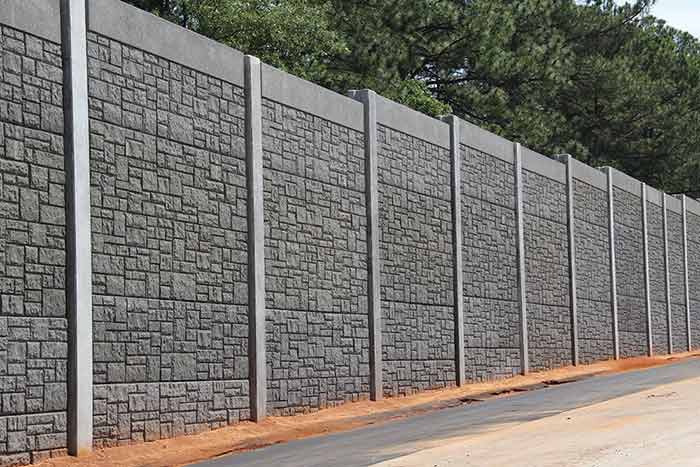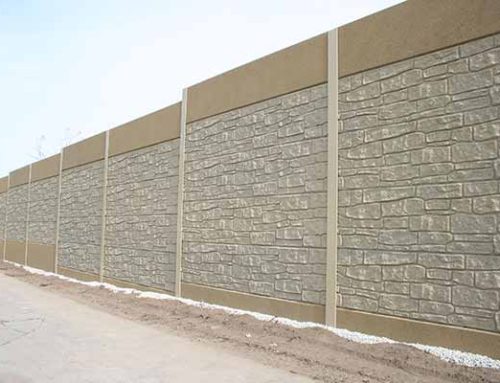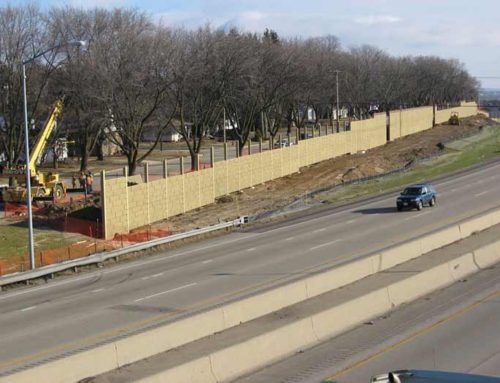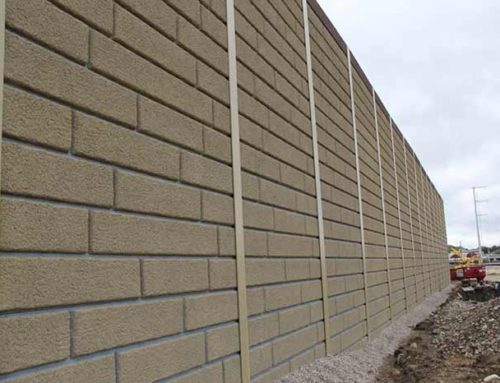The Santa Monica Freeway in California. Interstate 75 through Atlanta. The Dan Ryan Expressway in Chicago. Perhaps these countless acres of concrete and asphalt evoke painful memories of sitting in traffic for hours.
They are a small sampling of the busiest highways in North America. The busiest is the 401 in Ontario, Canada. It widens to 22 lanes in some areas, handling about 450,000 vehicles a day. That’s more than five vehicles a second. According to the FHWA, at least 13 highways in the U.S. are more than 12 lanes wide, and that number is growing. All that traffic creates a lot of noise, and managing the resulting sound is a major challenge for highway officials.
This noise affects residential homes or apartments, hospitals, schools, office buildings and nature areas. Numerous FHWA studies indicate that the most pervasive sources of noise today are those associated with transportation (1). An effective way to address such noise is the use of precast concrete sound walls.
Mass-ive noise reduction
Precast concrete sound walls are noise barriers, defined as solid obstructions built to divide roadways from residential or commercial areas. Noise barriers can be constructed from earth, concrete, masonry, wood, metal or other materials, but to effectively reduce sound transmission, the chosen material must be rigid and sufficiently dense (at least 37 lb/yd2 or 20 kg/m2).
Due to its mass, precast concrete offers a perfect solution for noise abatement, capable of reducing sound penetrating through a wall by more than 80% when compared to wood or steel. Additional benefits of precast concrete sound walls, including durability, ease of installation and aesthetic versatility, make it a top choice for noise reduction on a variety of transportation projects.
Precast concrete sound walls arrive on the job site ready to be installed, significantly reducing on-site labor compared to cast-in-place applications. As a result, projects can be completed quickly, saving time and money. Further, precast concrete has a long life cycle and is very resilient in the face of high winds, fire and rising waters, making it a sustainable building choice. Precast concrete sound walls can even be manufactured to be graffiti resistant (visit precast.org/graffiti).
To absorb or to reflect?
There are two types of precast concrete sound walls: absorptive and reflective. Absorptive sound walls take in sound energy while reflective sound walls push sound energy back across the source (away from the receiver) and into the atmosphere. Both types of sound walls force sound waves to take a longer path – over and around the barriers – reducing the amount of sound reaching the receiver. This is known as diffraction (Figure 1).
After passing through an absorptive precast concrete sound wall, lower amounts of sound energy remain to re-enter the environment, resulting in less noise reaching the ears of the receiver. Materials and finishes used to manufacture absorptive precast concrete sound wall panels and posts vary, but can include:
- Sound-absorptive aggregates
- Lightweight cellular material
- Composite materials
- Acoustic facing tile
- Textured/stamped concrete surface, porous finish or stamped brick
- Fibrous materials (fiberglass, mineral wool, recycled tire rubber, or recycled wood fibers or shavings)
Unlike absorptive sound walls, reflective sound walls are not manufactured with absorptive materials or finishes. Instead, producers rely on the natural materials found in concrete to force sound back toward the source or into the atmosphere at a significantly decreased level. When properly designed, a reflective precast concrete sound wall will effectively eliminate noise at the receiving location.
Six-mile silence
 Northeast of Columbia, South Carolina, work crews recently completed the first-ever installation of an absorptive sound wall in the state. The sound wall, which was installed across a six-mile stretch of Interstate 20, is over 600,000 sq ft in length.
Northeast of Columbia, South Carolina, work crews recently completed the first-ever installation of an absorptive sound wall in the state. The sound wall, which was installed across a six-mile stretch of Interstate 20, is over 600,000 sq ft in length.
JBM Solutions Inc. provided the technology for the sound wall system, including the forms, tools and handling devices. On site, the company also set up a temporary plant for production of the precast concrete pieces, training the work crews and quality control staff to produce, handle, store and ship the absorptive products.
The project’s precaster, Cherry Precast of Rural Hall, North Carolina, produced and shipped the absorptive panels. The precaster’s crews and quality control staff paid strict attention to detail, resulting in a highly effective noise barrier solution. Out of over 5,400 precast concrete panels produced and shipped to site, none were rejected due to quality issues.
Armtec, of Guelph, Ontario, also supported the project. The company provided the equipment necessary to produce Durisol, a highly sound absorptive material consisting of specially graded wood particles bonded with cement. Wood processing equipment milled local wood chips to the desired gradation, mineralizing equipment treated the milled wood chips and a fully contained high-tech batch plant mixed the Durisol to a constant consistency.
According to Jerry McNeal, president of JBM Solutions Inc., the installed sound wall is most likely the first of many more to come in the region. Currently, several state DOTs are monitoring the project to determine the success of the system. If the wall performs as designed, North Carolina and Georgia may install their first absorptive sound walls in the near future.
Peace and quiet
Noise is an undesirable byproduct of our modern ways of life. Those exposed to excessive noise levels over an extended period of time are often unaware of how it can interfere with sleep, work or recreation and in some cases even cause physical and psychological damage. Transportation noise is the most pervasive and difficult sound source to abate in society today. In an era of ever-widening highways, a concentrated effort is needed to control transportation noise using a system that is effective, durable and aesthetically pleasing. Precast concrete sound walls are the best solution capable of standing up to the challenge.
Claude Goguen, P.E., LEED AP, is NPCA’s director of sustainability and technical education.
Endnotes






